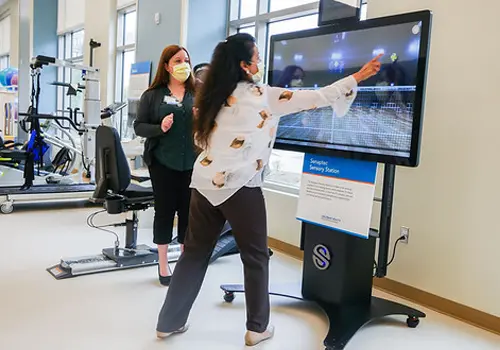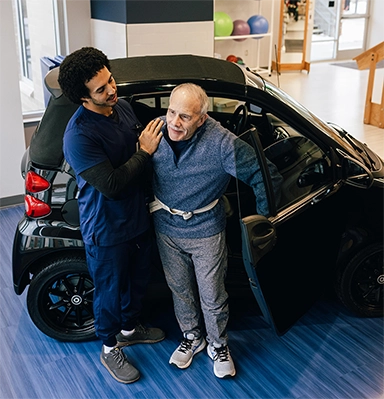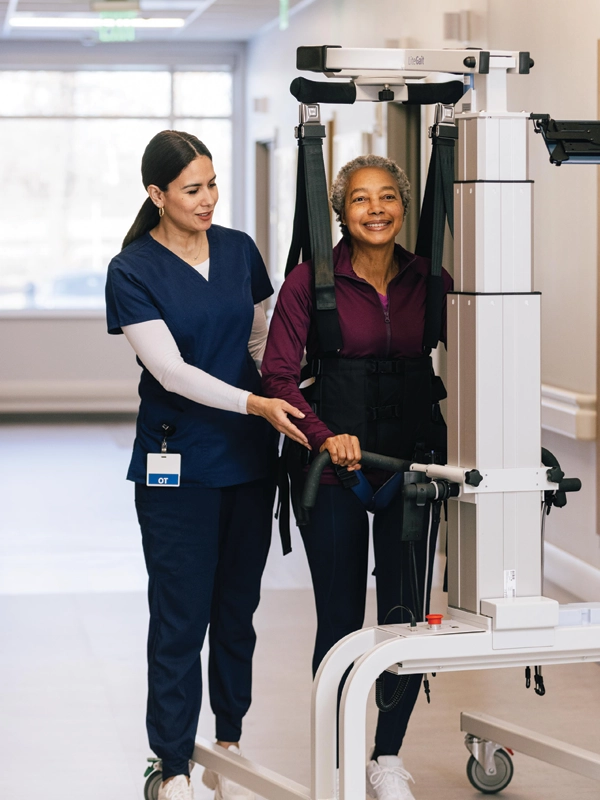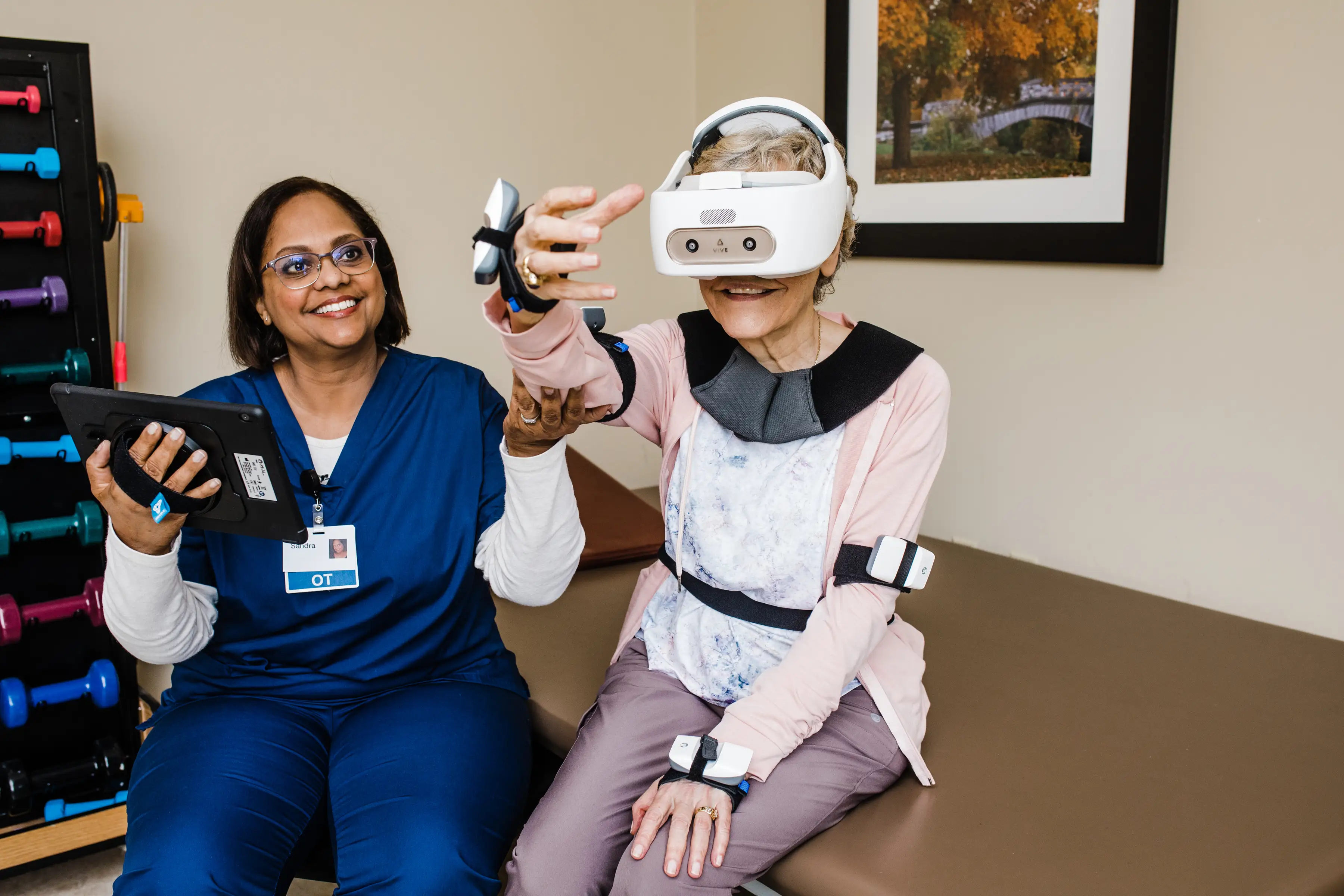Therapeutic Technology
Our hospital provides such leading-edge technology – as well as therapists trained to use it best – to ensure our patients are positioned to recover as quickly as possible.
Innovative Solutions for Superior Outcomes
New technology continues to push the boundaries of what once was considered full recovery from certain injuries or conditions. Today, for instance, top inpatient rehabilitation facilities deploy robotic tools that give stroke patients the ability to use their upper extremities again or help spinal cord injury patients with early ambulation.
Our hospital provides such leading-edge technology – as well as therapists trained to use it best – to ensure our patients are positioned to recover as quickly as possible.
Here are some examples of some of the industry’s best technology deployed at our hospital:
Senaptec Sensory Station
The Senaptec Sensory Station is a state-of-art sensory evaluation and training station that assesses ten visual and sensorimotor skills. The technology measures and trains an individual’s strengths and opportunities to improve sensory performance. The Senaptec Sensory Station is a software solution that provides a comprehensive sensory evaluation and training to maximize performance.

Smart Car
Our Smart Car is fully integrated into our rehab gym, allowing our patients to learn and practice car transfer skills year-round at any time during a treatment session. Car transfer training activities are essential to prepare our patients for community reintegration and setting them up for success when getting back to their daily activities.

LiteGait®
LiteGait® is a body-weight support system and gait training device that provides a safe environment for patients to participate in gait training over a treadmill or over the ground. This system allows patients to begin gait training earlier in the rehabilitation process and at a lower level than would be feasible with any other assistive device available. The LiteGait system eliminates the fear of falling and/or loss of balance with standing and walking tasks and allows the therapist the ability to provide manual assistance to the legs and pelvis throughout the gait cycle to facilitate proper gait patterns.

Vector Gait and Safety System
The Vector Gait and Safety System is a ceiling-mounted harness that automatically adjusts to the patient's center of gravity as they move. It allows patients to experience how it feels to fall and be caught, which can help them feel more comfortable and confident in the system to perform a variety of activities while maintaining a consistent level of body weight support. It also allows therapists to focus on the quality of movement and the overall mobility activity. The Vector can help patients with a range of mobility levels and is used to treat a variety of conditions, including stroke, brain injury, spinal cord injury, and Parkinson's disease. It can also be used for orthopedic injuries.
EksoGTTM
The EksoGT™ exoskeletal unit assists patients with early ambulation following a stroke or spinal cord injury. Ekso is a robotic exoskeleton that can be fitted to most patients to allow them to stand and ambulate early in the rehab process, which is key to their long-term prognosis. Clinical evidence indicates that gait training in the Ekso improves patients’ balance, walking distance, and gait speed outside of the device at discharge compared to admission.

Neuro Rehab VR
Neuro Rehab VR is transforming patient rehabilitation through an innovative blend of artificial intelligence, immersive virtual reality and clinical expertise. Designed specifically for patients recovering from strokes, brain injuries, spinal cord injuries, or managing neurodegenerative diseases, Neuro Rehab VR’s Smart TherapyTM Complete Solution provides personalized, gamified therapy exercises that can be adapted in real-time to each patient’s abilities and therapeutic needs.
By integrating cognitive and physical therapies within immersive virtual environments, Neuro Rehab VR significantly boosts patient motivation and engagement, accelerating recovery and improving therapeutic outcomes. This AI-driven solution not only enhances patient experiences but also dramatically streamlines clinician workflows, reduces burnout and provides administrators with valuable insights, ensuring scalable and impactful care delivery across diverse healthcare settings.

VitalStim® Therapy
Dysphagia is defined as difficulty with swallowing. It can occur as a result of a stroke or other neurological disease, normal aging or after a long period of inactivity. An estimated 15 million adults in the US currently suffer from dysphagia.
In the last few years, new treatment options have become available – especially the use of electrical stimulation. This exciting treatment tool, VitalStim® Therapy, is showing good outcomes in most patients with relatively few treatments. It is simple for certified clinicians to administer and is pain-free for the patient.
Who is a Typical Patient?
Typical patent categories include, but are not limited to:
- Those who experienced a stroke
- De-conditioning as a result of age or co-morbidity
- Head and neck cancer (post-radiation) and/or surgery
- Various neuromuscular disease processes (e.g., Parkinson’s, ALS, etc.)
Am I a Candidate for VitalStim Therapy?
If you show signs of aspiration or have difficulty managing your diet, you may be a candidate for dysphagia therapy. Look for one or more of the following signs and symptoms:
- Coughing/clearing throat after swallowing
- Decreased voice quality (wet, hoarse, weak)
- Multiple swallows or special maneuvers required to clear throat
- A feeling of food being stuck in the throat
- Difficulty initiating a swallow
- Abnormal volitional cough
- Recurring chest infections
- Difficulty completing a meal
- Modified diet required (thickening, pureeing food; soft solids)
- Spilling food or liquid from lips and/or drooling

